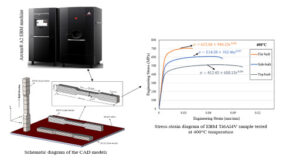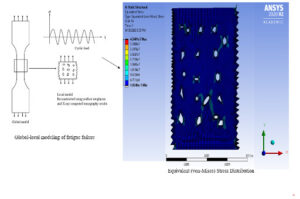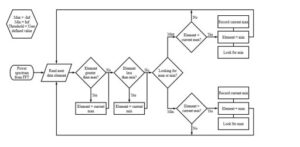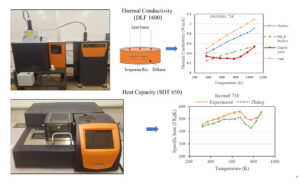Materials
Mechanical Behavior of Electron Beam Powder Bed Fusion Additively Manufactured Ti6Al4V Parts at Elevated Temperatures

This study focuses on the anisotropic high temperature elastic and plastic behavior of Ti6Al4V parts made using e-beam melting PBF process. Numerousmechanical properties, like modulus of elasticity, 0.2% yield strength, ultimate tensile strength (UTS), percent elongation etc., have been determined at 200°C, 400°C, and 600°C temperatures from the samples produced with different build orientations.
Modeling of fatigue crack initiation and propagation from various defects

In this study, a finite element analysis (FEA) modeling of fatigue crack initiation and propagation from inherent defects of as-built EBM Ti6Al4V parts is attempted. The microstructural finite element (FE) simulation of fatigue failure is approached by a global-local model scheme. A local model representing a portion of the global model, will also be built with distributed defects throughout the element. Eventually, a continuum damage modeling approach, for example successive initiation, will be used for predicting crack initiation sites and propagation directions.
Evaluating FFT Signals Peak Density Pattern to Characterize the Microstructure of Soft Tissue Phantom in High-Frequency Ultrasound Analysis

Acoustic scattering is a key feature of ultrasound which can be used to evaluate micro-structural features. In this study, the relationship between peak density and acoustic scattering was evaluated while varying micro-structural parameters like scatterer size, number of the scatterer, and propagation path of ultrasound. Peak density obtained from the frequency spectrum of phantoms with different micro-structure were compared to detect a pattern in micro-structural change.
Experimental measurement of thermal diffusivity, conductivity and specific heat capacity of metallic powders at room and high temperatures

This study is conducted to provide experimental information that has been missing from the bulk of the literature for variety of metallic powders commonly used in additive manufacturing processes. Additionally, a comparison between the experimental data and analytical models are conducted to determine the correlation and accuracy of these models.